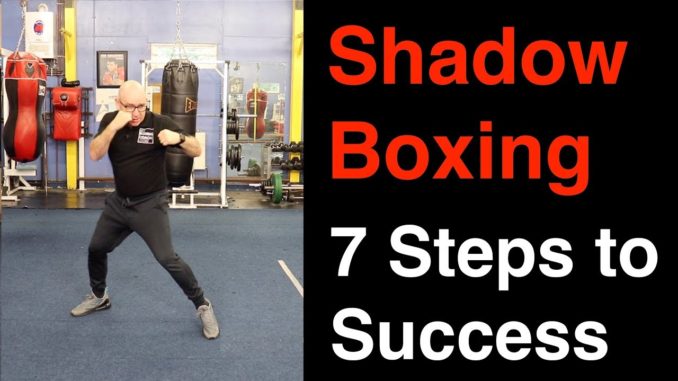
Shadow boxing seems such a fundamental part of a fighter’s life. We see boxers do it all the time. My favourite to watch was the one and only Muhammad Ali. His boxing style for me perfectly captured the essence of what shadow boxing is intended to be. The Greatest incorporated rhythm, fluidity, speed, relaxed power and stunning footwork. He would produce a mesmerising display that would have bystanders staring in amazement.
So what is ‘shadow boxing’ and how can we maximize the benefits on offer?
In The Mind
Boxers have always used shadow boxing within their training regime. In very basic terms, it is boxing without a physical opponent present. It allows you to try out many of the skills of boxing before deploying those skills on a heavy bag or indeed a real live opponent. As a matter of fact, you could argue that shadow boxing is more a work out for the brain than the body.
As a child I was taught how to play chess. As part of my learning I was provided with a book written by a couple of chess Grandmasters. The authors provided some pictures of chess positions, but a key condition that they laid down was that the reader should not use a chess board to physically work through the moves. The skill was in developing the mind to think 3, 4 or 5 steps ahead. This was the vital point.
Using this chess example to explain why boxers use shadow boxing might seem unusual at first, but the relevance is unmistakeable. It trains the mind and enables free-thinking by enabling the creation of any scenario possible. In fact, the effectiveness of shadow boxing is actually based upon the absence of a physical opponent rather than the presence of one.
Here’s my definition:
‘Shadow Boxing’ (noun) The process by which a boxer uses visualization to develop and enhance boxing skills.
Shadow boxing is more an exercise of the mind than the body. It is the next logical step to boxing drills. Where boxing drills use systematic, methodical repetition, shadow boxing demands flow, speed and pragmatism. It’s about placing yourself in a combat situation and planning the required tactics to overcome a particular type of opponent. You picture in your mind the way things need to be done and practice accordingly.
Shadow boxing is generally undertaken towards the start of the session, after the warm-up but before the ‘heavier impacts’ of sparring, punch pads or heavy bag work. Having said this, most boxers will occupy any spare moments with a burst of shadow boxing.
Some people consider it to be part of a warm-up, but I absolutely do not. For me it’s a very important aspect of training in it’s own right and should not be sacrificed for the more ‘exciting’ impact work.
My own approach is to apply a round-based structure just as I would with any other boxing training elements. So, work within the round/rest period structure and we don’t just mindlessly go through the motions in order to pass the time!
The Tips…
Here’s 7 pointers to get the most out of shadow boxing:
- Your emphasis should be on movement. Free-flowing, varied and slick bits of footwork and body movement. Whatever floor-space that you have during shadow boxing, make use of it!
- Visualize an opponent and place a target. Make it your business to put that physical opponent in there. Ensure that you think about your range in relation to the ‘opponent’ and also that the ‘opponent’ is a threat. Shadow boxing with an imaginary opponent who is no more dangerous than your average bunny rabbit is not the best use of your time.
- Accelerate your shots onto a target, snapping back the head of the ‘opponent.’ By thinking about the speed and acceleration of your punch, then you will both improve your punching speed and punching power.
- Related to the previous point, do not allow your punches to go through and beyond the target before eventually finding their way back to the guard position. This is a bad habit that needs to be avoided. When your fist hits a solid object it does not continue to travel for 2 feet beyond that object. The fist stops and the force of the punch passes to the object. So train for that situation of hitting the target. If during shadow boxing you don’t ‘hit a target’, then you are effectively training to miss.
- To improve your punching speed, Grab a 1lb or 2lb weight in each hand. Use the weights for a round then do without them for the next round. You should feel an instant improvement in punching speed.
- Give your rounds a theme. In round 1 you could visualize an opponent who is putting lots of pressure on you, constantly attacking. Use lots of side-steps,pivots and long range hooks and uppercuts to execute an effective fighting retreat. In the following round, turn the tables and you chase down your opponent.
- Watch other boxers, both on video and if you are at a gym the boxers working out there. Try to identify the skills that the boxers use. Look for the subtle stuff; pivots, hand-defences and footwork, and look to use some of those for a round. Basically, mimic your favourite boxers.
Finally, don’t take shadow boxing for granted. It is one of the most helpful aspects of the boxing training session. Enjoy and use it to become the boxer that you deserve to be. Shadow boxing will never be as effective as sparring or fighting, but it should always be seen as a fundamental part of your boxing training session.
Proudly WWW.PONIREVO.COM
by Fran Sands



